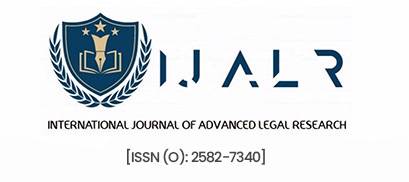Abstract
Human trafficking, particularly in the form of bride trafficking, remains one of the most pervasive and complex human rights violations, fuelled by socio-economic vulnerabilities, entrenched gender inequalities, and gaps in enforcement. This article examines the legal, social, and economic dimensions of the issue, highlighting both systemic failures and emerging preventive frameworks. It outlines the structural drivers, ranging from poverty and lack of education to gender-based discrimination, that facilitate trafficking networks, and critically assesses the adequacy of existing legal frameworks in addressing the crime. Through a comprehensive discussion of prevention strategies, law enforcement measures, and victim rehabilitation, the paper emphasizes the need for a multi-pronged, collaborative approach. The conclusion underscores that combating trafficking is not merely a legal necessity but a moral imperative, requiring integrated action from governments, civil society, and international partners to dismantle exploitative systems and restore dignity to survivors.
Keywords: human trafficking, bride trafficking, gender equality, victim rehabilitation, law enforcement, socio-economic vulnerability, cross-border cooperation, human rights violations, prevention strategies, moral imperative.
I. Introduction
Human trafficking is widely recognized as one of the gravest human rights violations in modern times, cutting across geographical, cultural, and socio-economic boundaries. It is a multi-billion-dollar criminal enterprise, second only to drug and arms trafficking in profitability, and thrives on systemic inequalities, weak enforcement mechanisms, and the vulnerability of marginalized communities. The United Nations Office on Drugs and Crime (UNODC) defines human trafficking as the recruitment, transportation, transfer, harbouring, or receipt of persons, by means of threat, coercion, abduction, fraud, deception, abuse of power, or exploitation of vulnerability, for the purpose of exploitation.[1] This exploitation may take various forms, including sexual exploitation, forced labour, servitude, organ removal, and forced marriage.
Globally, the legal understanding of trafficking is consolidated in the Protocol to Prevent, Suppress and Punish Trafficking in Persons, Especially Women and Children, 2000, popularly known as the Palermo Protocol, which supplements the United Nations Convention against Transnational Organized Crime. The Protocol establishes three critical elements for defining trafficking: the act (recruitment, transport, transfer, harbouring, or receipt), the means (threat, coercion, fraud, deception, or abuse of vulnerability), and the purpose (exploitation).[2] It also places obligations on States to criminalize trafficking, protect victims, and foster international cooperation.
India, as a signatory to the Protocol, has developed a multi-layered legislative framework to address trafficking.[3] The Immoral Traffic (Prevention) Act, 1956 (ITPA) focuses primarily on trafficking for commercial sexual exploitation, while provisions under theNew criminal law Bharatiya Nyaya Sanhita, 2023, Section 143, 144 (trafficking and exploitation of persons), Section 87, 96 (kidnapping, abduction, and procuration for marriage or illicit intercourse), Section 98 and 99 (selling and buying minors for prostitution), address other forms of trafficking. Additional protections exist under the Prohibition of Child Marriage Act, 2006, the Bonded Labour System (Abolition) Act, 1976, and various state-specific laws.
Within the broader ambit of human trafficking lies a particularly insidious form: bride trafficking. This refers to the recruitment and transfer of women and girls, often across state or national borders, for the purpose of forced or exploitative marriage. Unlike consensual unions, these marriages are frequently a cover for long-term exploitation, including sexual abuse, forced domestic labour, reproductive coercion, and restrictions on freedom of movement. In many cases, victims are treated as commodities, bought, sold, and traded, stripped of their autonomy and basic rights.
Bride trafficking often thrives in regions with skewed sex ratios, poverty, and entrenched patriarchal practices.[4] In India, factors such as son preference leading to female foeticide, dowry demands, and economic deprivation create a fertile ground for the trafficking of brides, particularly from poorer states like Assam, West Bengal, Jharkhand, Odisha, and Bihar to states with gender imbalances like Haryana, Punjab, and Rajasthan. Cross-border bride trafficking is also prevalent, involving victims from neighbouring countries such as Nepal, Bangladesh, and Myanmar.
In the contemporary socio-legal context, addressing bride trafficking is of urgent importance. It not only intersects with issues of gender-based violence, modern slavery, and reproductive rights, but also raises questions about how cultural norms and economic factors perpetuate systemic exploitation.[5] Understanding bride trafficking as part of the wider trafficking framework enables the development of targeted legal, policy, and community-based interventions, ensuring that responses are comprehensive, rights-oriented, and survivor-centred.
[1]Protocol to Prevent, Suppress and Punish Trafficking in Persons, Especially Women and Children, Nov. 15, 2000, 2237 U.N.T.S. 319.
[2]Convention on the Elimination of All Forms of Discrimination Against Women, Dec. 18, 1979, 1249 U.N.T.S. 13.
[3]G.A. Res. 70/1, Transforming Our World: The 2030 Agenda for Sustainable Development (Oct. 21, 2015).
[4]The Immoral Traffic (Prevention) Act, 1956, No. 104 of 1956, INDIA CODE.
[5]Indian Penal Code, No. 45 of 1860, §§ 366, 366A, 370, 370A, 372, 373, INDIA CODE or Bharatiya Nyaya Sanhita, 2023, No. 45 of 2023, §§ 87, 96, 143,144, 98, 99, INDIA CODE.

